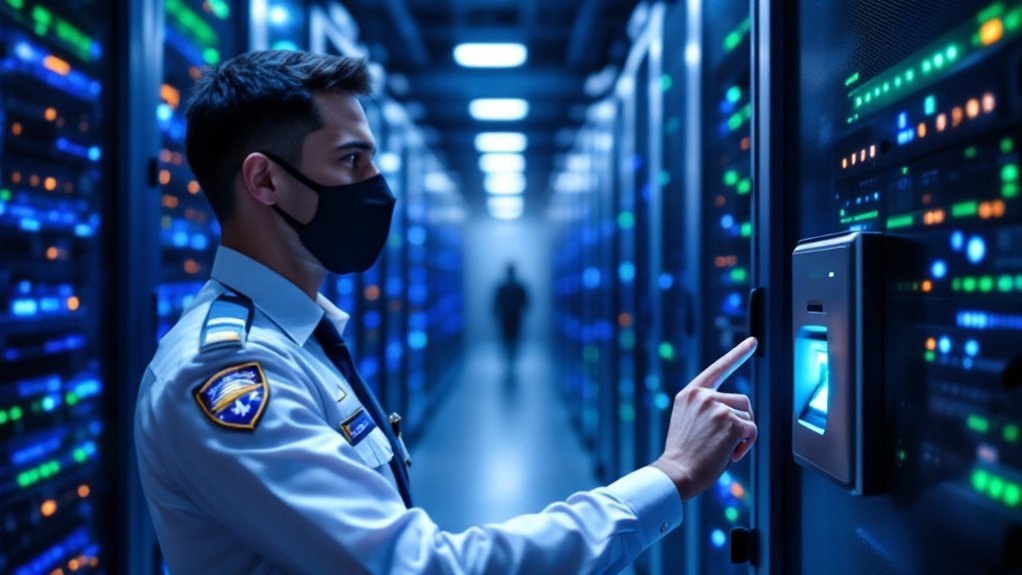In the complex world of data center security, access control serves as a critical bulwark against unauthorized intrusions. By regulating who can access what, it safeguards the sanctity of sensitive information. However, implementing an effective access control strategy is not without its challenges. From understanding the different types of controls to choosing the most suitable ones, the journey is fraught with complexities. Intrigued? Let’s explore this further.
Understanding the Concept of Access Control in Data Centers
Although often overlooked, the concept of access control in data centers is a critical aspect of information security. Access control refers to the selective restriction of access to data. It involves a system that allows, denies, or limits the use of resources in a computing environment. It is a necessary measure that provides a means of protecting the confidentiality, integrity, and availability of data stored in the center. In data centers, access control can be implemented through various methods such as the use of passwords, biometric scans, or smart cards. Correctly configured, it guarantees only authorized individuals can access the data, thereby minimizing the risk of unauthorized disclosure, alteration, or destruction of information. Additionally, data management services ensure that access control measures are consistently updated and monitored for effectiveness.
The Integral Role of Access Control in Data Security
Access control plays an essential role in the security of data centers. By understanding this concept and the various mechanisms involved, one can effectively mitigate potential security risks. Therefore, a thorough understanding of access control is imperative for safeguarding sensitive data. Database management ensures safety and quality of data, protecting it from unauthorized access and potential breaches.
Understanding Access Control
In the domain of data security, one cannot overlook the critical role played by access control. It serves as a critical gatekeeper, determining who or what can view or use resources in a computing environment. It is fundamentally a selective restriction of access to data—a system that protects confidential information from being accessed by unauthorized individuals or systems. The core objective is to minimize security risks and prevent unauthorized access to important data, be it sensitive personal information or proprietary business data. A well-implemented access control system guarantees that only authorized users can access specific resources, thereby enhancing the overall security of data centers. Understanding its role is pivotal to appreciating the need for robust security mechanisms in data centers.
Access Control Mechanisms
Undeniably, the role of access control mechanisms in data security is essential. These tools function as the gatekeepers of invaluable data, guaranteeing only authorized personnel can access sensitive information. They can be physical, like biometric scanners and smart cards or logical, such as passwords and firewalls. Physical mechanisms provide tangible security, controlling physical access to data centers. Logical mechanisms, on the other hand, monitor and regulate digital access to data. They can also track user activities, providing vital data for audits. Different mechanisms have different strengths and weaknesses, which should be considered when designing a security system. As a result, a combination of these access control mechanisms is often employed to guarantee thorough data protection. Their integral role cannot be overstated in maintaining data integrity and confidentiality.
Mitigating Security Risks
Mitigating security risks presents an essential challenge for data centers, with access control mechanisms playing a significant role in the process. These mechanisms guarantee that only authorized individuals gain access to sensitive data, thereby reducing potential threats. For example, biometric systems and key card readers can be utilized as physical barriers to unauthorized access. Additionally, software-based controls can limit network access and monitor for unusual activity patterns, which could indicate a potential security breach. Regular audits and updates to access control measures are also vital to maintain continued data security. Fundamentally, robust access control systems are integral to minimizing security risks in data centers, thereby protecting critical business information and maintaining trust with stakeholders.
Different Types of Access Controls Used in Data Centers
While ensuring the security of data centers, a significant measure employed is access control. There are several types of access controls utilized: physical, logical, and administrative. Physical access controls restrict physical entry to data centers and include measures like keycards, biometric scanners, and video surveillance. Logical access controls focus on digital restrictions, including password protection, firewalls, and encrypted data transfer. Administrative access controls, on the other hand, are policies and procedures established by management to regulate who can access specific data. This includes user permissions, segregation of duties, and personnel screening. These controls, in combination, create a thorough access control system, ensuring data centers remain secure and operational. Additionally, data centers emphasize the importance of client database safety to bolster their access control measures.
Implementing Effective Access Control Strategies
In the domain of data centers, the implementation of effective access control strategies is paramount. A thorough grasp on the basics of access control is necessary, followed by the application of essential strategies. Finally, the effectiveness of these strategies needs to be evaluated to guarantee the security of the data center. Additionally, planning your database management involves cooperation from all stakeholders to ensure a comprehensive security approach.
Understanding Access Control Basics
Guaranteeing the security of data centers is a critical responsibility that hinges on a thorough understanding of access control basics. It begins with identification, where users are verified based on credentials such as usernames or ID cards. Following this, authentication occurs, typically through passwords or biometrics to confirm the user’s identity. The next phase, authorization, dictates what the authenticated user can access within the data center. This is often enforced through permissions and roles assigned to each user. The final step, accountability, guarantees that all actions within the data center are recorded for audit purposes. Understanding these four cornerstones—identification, authentication, authorization, and accountability—is pivotal for robust access control implementation.
Essential Access Control Strategies
Given the foundational understanding of access control basics, it is essential to explore the fundamental strategies for implementing effective access control. First, regular updating of access permissions is critical to accommodate staff changes and guarantee only authorized individuals can access data. This involves revoking access for former employees and adjusting permissions as roles evolve. Next, the principle of least privilege (PoLP) should be applied, granting employees only the access they need to perform their job. Additionally, multi-factor authentication (MFA) further strengthens access control by requiring multiple forms of identification. Finally, physical controls, such as biometric scanners and card readers, enhance security by restricting physical access. These strategies, when properly applied, bolster data center security considerably.
Evaluating Access Control Effectiveness
While implementing access control strategies is an essential step, evaluating their effectiveness is equally important to maintain robust data center security. This evaluation process should not be a one-time event but a continuous part of the security strategy, ensuring that systems are working as intended. Regular audits and assessments can identify any weaknesses or vulnerabilities, allowing for timely remediation. Key performance indicators to measure effectiveness might include the number of security breaches, unauthorized accesses, system downtimes, and user complaints. The use of advanced analytics can also provide valuable insights into access control effectiveness. Ultimately, the goal is to continually refine and improve these strategies, ensuring that the data center remains secure in an evolving threat landscape.
Challenges in Enforcing Access Control in Data Centers
Despite the critical importance of access control in data centers, implementing it effectively presents some formidable challenges. One significant challenge is the rapid technological progression, which continually introduces new vulnerabilities that require updated security measures. Another difficulty lies in managing complex user permissions, as data centers often house information for multiple organizations. Furthermore, enforcing strict access control can inadvertently impede workflow, as employees may struggle with cumbersome security measures. Additionally, the human element introduces risk. Even with stringent controls, human error or malicious activity can lead to breaches. Ultimately, cost considerations often pose a challenge. Implementing a robust access control system can be expensive, and budget constraints may limit the degree of security that can be enforced. Furthermore, data management topics discussed in webinars often highlight the need for effective access control measures.
Case Studies: The Consequences of Inadequate Access Control
Examining real-life incidents can illuminate the severe consequences of inadequate access control in data centers. In 2014, Code Spaces, a code-hosting company, suffered a devastating data breach. Hackers gained control due to weak access protocols, deleting most client data and backups, leading to the company’s closure. In another incident, a 2016 attack on a Ukrainian power grid was traced to poor access control, resulting in widespread blackouts. Similarly, a 2019 breach at Capital One exposed the data of over 100 million customers, attributed to a configuration vulnerability in the company’s web application firewall. These cases underscore the criticality of robust access controls to protect data centers from both external threats and internal vulnerabilities.
Future Trends in Data Center Access Control
As technology advances, so too will the features and functionalities of access control systems in data centers. Biometric access control, currently a premium feature, will become standard, providing enhanced security by using unique biological traits. Integration with Internet of Things (IoT) devices will allow for real-time monitoring and instant notifications of security breaches. Artificial Intelligence (AI) will play a critical role, with machine learning algorithms predicting potential threats and mitigating them proactively. The trend towards cloud-based access control systems will continue, offering scalability and remote accessibility. Finally, greater emphasis will be placed on user-friendly interfaces, ensuring ease of use without compromising security. These advancements signal an exciting future for data center access control.
Frequently Asked Questions
What Is the Cost of Implementing Access Control in a Data Center?
The cost of implementing access control in a data center varies greatly. Factors include the center’s size, chosen system, and security needs. It can range from thousands to millions, promising a significant return on investment.
How Often Should Access Controls Be Updated or Reviewed?
It’s crucial to regularly update and review access controls. Ideally, this should be done quarterly. However, any significant changes in personnel or system structure necessitate immediate revisions to guarantee continued security and data integrity.
What Training Is Required for Data Center Staff to Manage Access Control?
For data center staff to manage access control, thorough training in cybersecurity, system administration, and data protection is required. They should also be updated on emerging threats and regulatory compliance requirements for robust safeguarding of information.
How Does Access Control in Data Centers Comply With Data Privacy Laws?
Access control in data centers adheres to data privacy laws by allowing only authorized personnel to access sensitive information. It includes measures such as password protection, physical barriers, and biometric security to guarantee data confidentiality and integrity.
Can Access Control Systems in Data Centers Be Integrated With Other Security Measures?
Yes, access control systems in data centers can be integrated with other security measures. This integration enhances overall security, allowing for thorough monitoring, detection and prevention of unauthorized access or potential security breaches.
Conclusion
To summarize, access control in data centers is essential to maintaining data security. Various mechanisms, both physical and logical, play a crucial role in preventing unauthorized breaches. While implementing effective strategies can be challenging, their importance is underscored by the severe consequences of inadequate control. As threats evolve, so must access control measures, signifying their ongoing relevance in the future of data center security.






